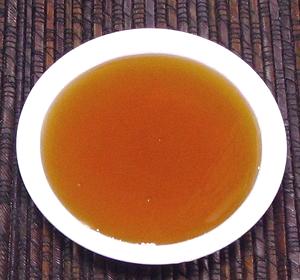 [Ssalyeot (Korea); Brown Rice Syrup]
[Ssalyeot (Korea); Brown Rice Syrup]
This syrup is available in most Korean markets, at least here in Los Angeles. Preferably it will be labeled "100% rice" with no other ingredients. It has the same consistency as honey but with a lighter flavor, and is about 1/3 as sweet as honey or sugar. It has more malt flavor than Mulyeot (malt syrup) which is made somewhat differently.
Health Food outlets now sell "Brown Rice Syrup", mostly from California rice grower Lundberg Farms, which is similarly made. In the "health concious" market, it is replacing Agave Nectar as a "healthier than sugar" sweetener, which it is not (but it is healthier than Agave Nectar, which is almost pure Fructose). It is at least three times the calories as table sugar for the same sweetness, and has a much higher glycemic index.
Originally, this syrup was made by adding some barley malt to rice starch, but today purified bacterial or fungal produced enzymes are generally used. These convert the starch to sugars, nearly all maltose.
Subst: The amber Mulyeot (malt syrup) would be closest, just a little lighter flavor. The Lundberg product would be the closest American substitute, and next closest is is Corn Syrup. Not the "High Fructose" variety, but plain corn syrup, like Karo Light. The malt flavor will be missing, and Corn Syrup is significantly sweeter, but it will work for sweetness and glaze. Corn syrup is almost entirely Glucose, which is not as sweet as Sucrose. Maltose is two glucose molecules bound together and is less sweet than glucose, with a just slightly lower glyceminc index.
More on Sweeteners.
This is a somewhat confusing ingredient, because Koreans often refer to Ssalyeot as Mulyeot, which today is often just corn syrup. The word "Mulyeot" simply means "liquid candy". Korean cookbooks in English, especially older ones, presume you can't get this ingredient, and often list "honey" or "sugar" instead.
This is a fairly common ingredient in Korean cooking, and similar products are used in Japan, and in China, particularly for creating the glaze on Peking Duck. Adherence to tradition may vary greatly from brand to brand. The photo sample, distributed by Ottogi America Inc. of Gardena, California, was purchased from a Korean market in Los Angeles for 2015 US $3.99 for 24.69 ounces (700 grams). Ingred: Rice.
Cooking: This syrup is often mixed with Soy Sauce and other seasonings used in stir fries and coatings for meat. It provides a light sweetening and an attractive glaze.
Arsenic: Some rice has a very high arsenic content, and baby food products made with rice syrup have been found to have as much as 6 times the maximum arsenic content allowed by the FDA. California rice and rice from Asia doesn't have this problem, it is mainly with rice from the United States south, (Texas, Louisiana, etc.). In that region, chicken and turkey droppings are used as fertilizer for rice. Chicken and turkey farms in the region have long fed the birds arsenic to make them grow faster. Happy Thanksgiving.
sw_ricesz 151020 - www.clovegarden.com